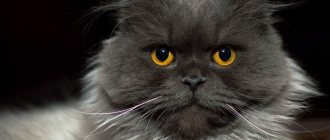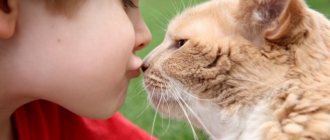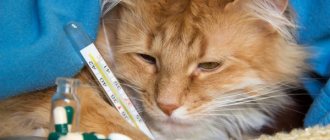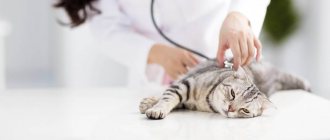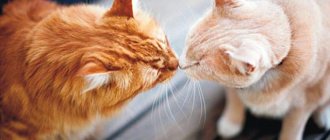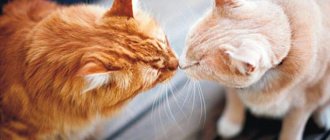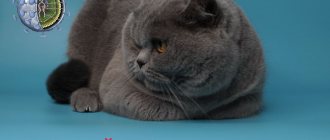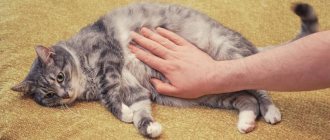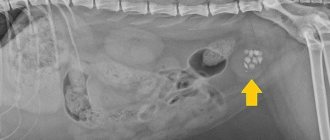Despite its modest size, a small lump in the anal area can significantly ruin the life of a pet. Prolapse of hemorrhoids occurs due to a shift in the center of gravity to the pelvic area. People who lead a sedentary lifestyle often suffer from this problem.
Unlike humans, domestic animals move not on two, but on four limbs. Their center of gravity is in the chest area. Owners who know this don’t even think about whether their cat might have hemorrhoids, because they are sure that this is impossible. Despite the logical justification, this opinion is erroneous.
Do male cats get hemorrhoids?
Dilation of the veins in the rectum in mustachioed pets is a rare, but still common phenomenon. Inflammation caused by impaired blood flow leads to deformation of blood vessels. They intertwine into knots and fall out of the anus, causing unpleasant and painful sensations during emptying.
If you suspect that your cat has hemorrhoids, check with your veterinarian about what to do. Despite the similarity of the main symptoms of the disease, the treatment of mustachioed pets and humans is very different.
Causes of the disease
The main cause of feline hemorrhoids is blood stagnation, which reduces the tone of the blood vessels. This dangerous violation occurs under the following factors:
- advanced form of worm infection;
- cancerous tumors in the intestines;
- excess weight, fraught with the growth of cholesterol plaques;
- diseases of the urinary system (cystitis, urolithiasis);
- excessive or low physical activity;
- too short breaks between matings in breeding animals (with frequent pregnancies, the pressure in the pelvis remains at a dangerously high level);
- intestinal obstruction and frequent constipation;
- dehydration and poor nutrition (low amount of vitamins and lack of balance of KBJU);
- hormonal imbalances.
If your pet eats economy-class food, is neutered or is prone to obesity (Sphinxes, Persians, British), then he is at risk. A predisposition to pathology is inherited, so when buying a kitten, be sure to check all the diseases that its parents have encountered.
Let's sum it up
Cats of any age do not tolerate hemorrhoids well. The fact is that this illness is extremely painful for them, especially if there are any concomitant illnesses. At the same time, unfortunately, changes in the behavior of our pets cannot always be associated with illness. So, for example, if you just adopted a new pet, your cat's quirks may seem like just jealousy. In order not to waste precious time, try to carefully study all the symptoms we listed in the text.
If hemorrhoids are not treated in time, they can transform into other ailments, such as cancer, so you should not put off visiting a veterinarian
In addition, it would be a good idea to remove your cat from the risk group for this disease even before hemorrhoids appear. So, if you have an obese animal, start playing with him today, change the water in the bowl of the cat who drinks little (maybe you just rarely do this), change his diet and add more liquid. And remember: your pet’s health depends only on your efforts.
Symptoms of pathology
Symptoms of hemorrhoids in cats develop progressively. You can notice a disorder at an early stage only by behavioral changes, so it is very important not to ignore your pet’s mood changes.
Signs at different stages
A sick pet becomes nervous and restless. He loses his usual activity and appetite, devoting most of his time to anal hygiene.
More obvious signs develop in 3 stages:
- The hemorrhoid is located inside. It cannot be detected visually, but can be felt. The small compaction takes on a spherical shape.
- The node, swollen with blood, gradually falls out. The round shape changes to a cone shape.
- Under pressure, the vessels become thinner, so during defecation they are injured and bleed. At the site of the bump, a small bleeding ulcer appears, gradually increasing in size.
The resulting pain affects gait and bowel movements. When moving, the animal spreads its hind legs wide, trying not to touch the deformed veins. There is stool retention, drying of stool, and the appearance of mucous and bright scarlet discharge.
If your pet meows pitifully in the toilet, and its anus is red and swollen, sign up for an examination at the veterinary clinic. Otherwise, an infection may get into the open wound, aggravating the patient’s condition and complicating further treatment.
Similar diseases
Prolapse of hemorrhoids is a fairly rare pathology, so do not rush to look for a cure before making a diagnosis. Most often, the cause of the disorder is other diseases with similar symptoms:
- neoplasms and hernia in the intestine, as well as rectal prolapse, characteristic of animals with weak sphincter muscles;
- inflammation of the paraanal glands - small sacs with odorous secretions located immediately behind the entrance to the anus;
- helminthic infestation, accompanied by frequent licking due to itching;
- anal fissure, that is, spontaneous damage to the mucosa;
- ulcerative colitis, or inflammation of the large intestine.
Despite the similarity of symptoms, all of these diseases have different treatment regimens. For this reason, you should not draw conclusions until your pet is fully examined.
Why is it so important to visit a veterinarian?
An examination by a veterinarian ensures a correct diagnosis. After conducting all the necessary research, he will explain how to treat hemorrhoids in a kitten or adult animal and select safe dosages of medications.
In addition to confirming a specific violation, it is important to determine its cause. This will help get rid of the existing problem and prevent its occurrence in the future.
Risk group
Snot in a kitten, cat and cat: how to treat it
A variety of felines are susceptible to the disease. Pets at risk include:
- Spayed or neutered. In this case, the disease may develop due to changes in the animal’s hormonal levels.
- Breeds prone to obesity. These include: British, Scottish Fold, and so on. For them, it is necessary to select special food and carefully monitor the animal’s weight.
- Cats eating low-quality foods, such as dry food such as Whiskas or a cheaper category.
- Having a genetic tendency passed on from their parents.
Obesity can cause hemorrhoids in cats
How to treat hemorrhoids in cats and kittens at different stages
Treatment for hemorrhoids in cats depends on its stage. At the initial stage, drug therapy is sufficient for recovery, but at a later stage, surgery cannot be avoided.
Light form
A mild form can be treated at home by reviewing the diet, proper hygienic care for the inflamed anus, and medications prescribed by a doctor. Depending on the condition, a mustachioed patient may be prescribed the following medications:
- anti-inflammatory and antibacterial ointments;
- venotonics, normalizing blood flow and restoring the integrity of damaged vessels;
- hemostatic suppositories and painkillers;
- laxatives that soften too hard and dry stools.
Among folk remedies, it is recommended to use sea buckthorn oil and yarrow infusion, which reduce inflammation. Before use, be sure to consult a veterinarian so as not to make a mistake in the dosage.
Launched form
Large ulcerations accompanied by severe bleeding must be removed. The operation is carried out using:
- cryosurgery, that is, freezing with liquid nitrogen;
- classical excision of dilated veins with a scalpel.
The first method is less invasive (with a minimum of intervention) and does not require the use of general anesthesia. After waking up, the mustachioed patient is returned to the owner, not forgetting to prescribe him multivitamins and wound-healing ointments.
Prevention
- Carry out preventive deworming once every six months.
- Monitor proper nutrition and drinking regime. Alternate dry and soft food, include vitamins and minerals and fatty acid complexes in the cat’s diet.
- If you experience prolonged constipation or diarrhea, contact your veterinarian immediately.
- If the cat does not take good care of its hygiene, then periodically clean the anus area with wipes.
- Monitor your pet’s weight; if there are signs of excess weight, increase physical activity and ensure a balanced diet.
Diet and care
The main goals of a therapeutic diet are to return the natural consistency of stool and reduce the load on the inflamed intestines. New nutrition involves:
- Switch to easily digestible foods. All dishes are boiled or steamed, since the lack of heat treatment complicates the digestion process. You can cook rice, oatmeal or buckwheat porridge using the broth left after cooking meat.
- Chop food thoroughly before serving. Too large an unchewed piece can injure the mucous membrane.
- Enriching the diet with fiber and vitamins. Use special probiotics, vitamin complexes or bran soaked in kefir. Remember that all fermented milk products must have minimal fat content and an expiration date.
- Switching to veterinary food. The lack of water is compensated for with wet canned food from the same line, intended for the treatment of gastrointestinal pathologies.
In addition to changing your diet, it is important to reconsider your existing load. Fluffy couch potatoes are encouraged to play actively, and pets that are too restless are temporarily restricted in their movements.
Before recovery, you need to take care of hygiene. Clean the anus and perineum twice daily with warm water or alcohol-free wipes. After washing, be sure to lubricate the anus with antiseptic ointment or Vaseline oil. This will prevent infection from entering the wound and speed up its healing.
Bibliography
- Vovk, E.I. Hemorrhoids: emergency care, treatment strategy, prevention / E.I. Vovk. - Text: electronic // Russian Medical Journal, 2001 - No. 20. — URL: / (date accessed 12/26/2021).
- Clinical recommendations “Hemorrhoids”, 2020. Developer: All-Russian public organization “Association of Coloproctologists of Russia”. - Text: electronic. - URL: (access date 12/26/2021).
- Mudrov, A.A. Perioperative management of patients with chronic hemorrhoids/A.A. Mudrov.-Text: direct //Medical Council, 2012. - No. 3.- P.40-44.
- Rivkin, V.L. Modern ideas about the pathogenesis, forms and treatment of hemorrhoids / V.L. Rivkin. - Text: immediate. // Consilium Medicum, 2017. - No. 19 (7.1. Surgery). – pp. 57-61.
- Savelyev, V.N. Relationship between the incidence of hemorrhoids and professions and gender in the urban district of Izhevsk for 2015 and 2022 / V.N. Savelyev, L.I. Gadelshina, K.A. Merzlikina.- Text: direct // // StudNet, 2020. – No. 12 – pp. 14-19.
- Styazhkina, S.N. Hemorrhoids as a leading problem in proctology/S. N. Styazhkina, A.A. Khairullin, L.I. Gadelshina, K.A. Merzlikina. – Text: immediate // StudNet, 2022. – No. 4 – P. 19-21.
